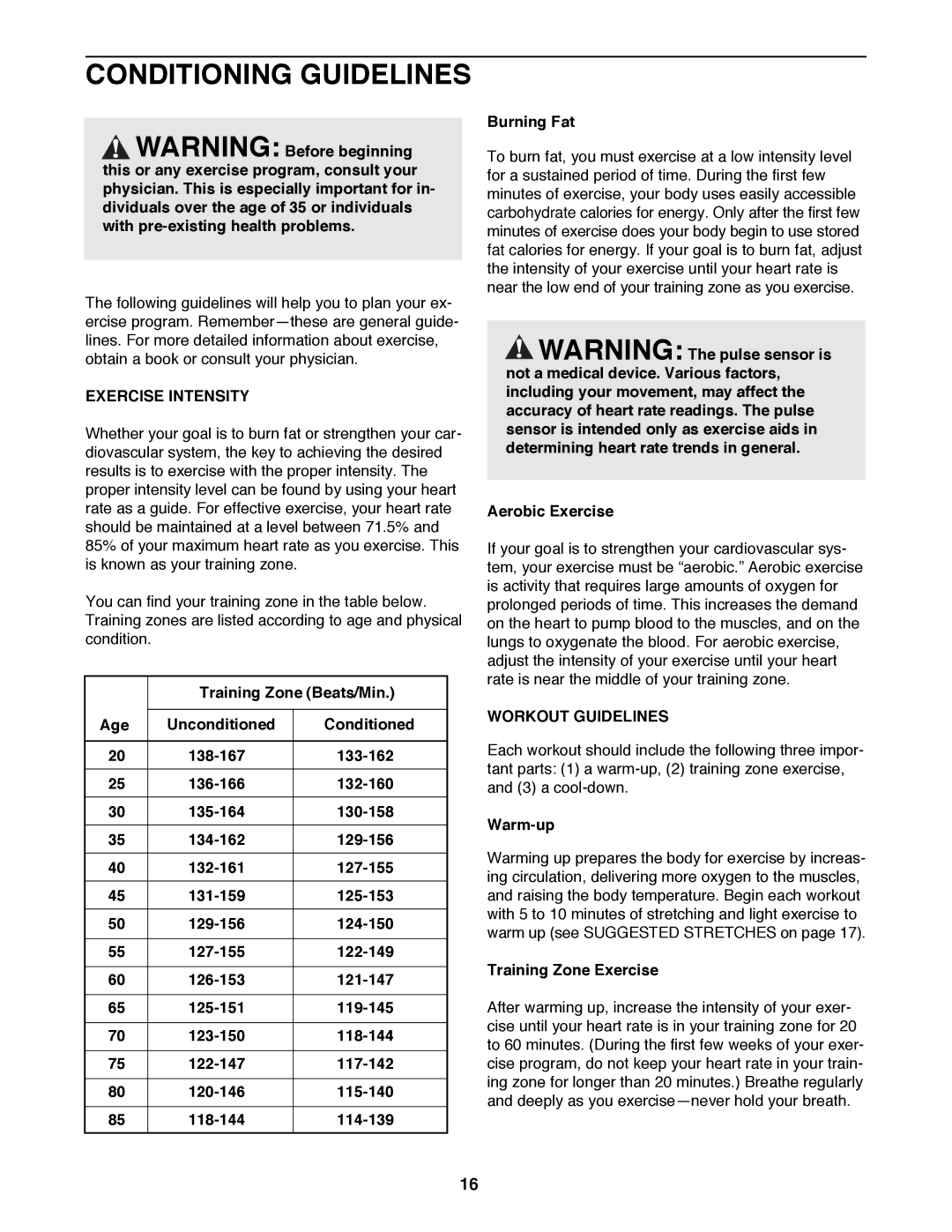
CONDITIONING GUIDELINES
![]() WARNING: Before beginning this or any exercise program, consult your physician. This is especially important for in- dividuals over the age of 35 or individuals with
WARNING: Before beginning this or any exercise program, consult your physician. This is especially important for in- dividuals over the age of 35 or individuals with
The following guidelines will help you to plan your ex- ercise program. RememberÑthese are general guide- lines. For more detailed information about exercise, obtain a book or consult your physician.
EXERCISE INTENSITY
Whether your goal is to burn fat or strengthen your car- diovascular system, the key to achieving the desired results is to exercise with the proper intensity. The proper intensity level can be found by using your heart rate as a guide. For effective exercise, your heart rate should be maintained at a level between 71.5% and 85% of your maximum heart rate as you exercise. This is known as your training zone.
You can find your training zone in the table below. Training zones are listed according to age and physical condition.
|
|
|
| Training Zone (Beats/Min.) | ||||
|
|
|
|
|
|
|
|
|
|
|
|
|
|
|
|
|
|
| Age |
|
| Unconditioned | Conditioned | |||
|
|
|
|
|
|
|
|
|
|
|
|
|
|
|
|
|
|
|
|
|
|
|
|
|
|
|
|
|
|
|
|
|
|
|
|
20 |
|
|
| |||||
|
|
|
|
|
|
|
|
|
25 |
|
|
| |||||
|
|
|
|
|
|
|
|
|
30 |
|
|
| |||||
|
|
|
|
|
|
|
|
|
35 |
|
|
| |||||
|
|
|
|
|
|
|
|
|
40 |
|
|
| |||||
|
|
|
|
|
|
|
|
|
45 |
|
|
| |||||
|
|
|
|
|
|
|
|
|
50 |
|
|
| |||||
|
|
|
|
|
|
|
|
|
55 |
|
|
| |||||
|
|
|
|
|
|
|
|
|
60 |
|
|
| |||||
|
|
|
|
|
|
|
|
|
65 |
|
|
| |||||
|
|
|
|
|
|
|
|
|
70 |
|
|
| |||||
|
|
|
|
|
|
|
|
|
75 |
|
|
| |||||
|
|
|
|
|
|
|
|
|
80 |
|
|
| |||||
|
|
|
|
|
|
|
|
|
85 |
|
|
| |||||
|
|
|
|
|
|
|
|
|
Burning Fat
To burn fat, you must exercise at a low intensity level for a sustained period of time. During the first few minutes of exercise, your body uses easily accessible carbohydrate calories for energy. Only after the first few minutes of exercise does your body begin to use stored fat calories for energy. If your goal is to burn fat, adjust the intensity of your exercise until your heart rate is near the low end of your training zone as you exercise.
![]() WARNING: The pulse sensor is not a medical device. Various factors, including your movement, may affect the accuracy of heart rate readings. The pulse sensor is intended only as exercise aids in determining heart rate trends in general.
WARNING: The pulse sensor is not a medical device. Various factors, including your movement, may affect the accuracy of heart rate readings. The pulse sensor is intended only as exercise aids in determining heart rate trends in general.
Aerobic Exercise
If your goal is to strengthen your cardiovascular sys- tem, your exercise must be Òaerobic.Ó Aerobic exercise is activity that requires large amounts of oxygen for prolonged periods of time. This increases the demand on the heart to pump blood to the muscles, and on the lungs to oxygenate the blood. For aerobic exercise, adjust the intensity of your exercise until your heart rate is near the middle of your training zone.
WORKOUT GUIDELINES
Each workout should include the following three impor- tant parts: (1) a
Warm-up
Warming up prepares the body for exercise by increas- ing circulation, delivering more oxygen to the muscles, and raising the body temperature. Begin each workout with 5 to 10 minutes of stretching and light exercise to warm up (see SUGGESTED STRETCHES on page 17).
Training Zone Exercise
After warming up, increase the intensity of your exer- cise until your heart rate is in your training zone for 20 to 60 minutes. (During the first few weeks of your exer- cise program, do not keep your heart rate in your train- ing zone for longer than 20 minutes.) Breathe regularly and deeply as you exerciseÑnever hold your breath.
16
